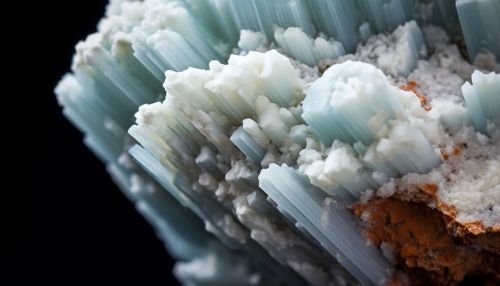Zeolite
Introduction
Zeolites are a group of minerals that are essentially hydrated aluminosilicates of the alkaline and alkaline-earth metals. They are characterized by a framework structure that encloses interconnected cavities occupied by large metal cations (positively charged ions) and water molecules.


Structure and Properties
The basic structure of zeolites is a three-dimensional framework of tetrahedrally coordinated silicon and aluminum atoms. Each tetrahedron consists of a central atom surrounded by four oxygen atoms. The tetrahedra are linked together by shared oxygen atoms to form a variety of structures ranging from rings and chains to large cage-like cavities. These cavities are typically occupied by water molecules and metal cations, which can be readily exchanged for other ions in a surrounding liquid. This ion-exchange property is one of the key features of zeolites and is responsible for many of their practical applications.
Zeolites are also characterized by their ability to lose and gain water without significant change in structure. This property, known as dehydration and rehydration, is another important feature of zeolites and is exploited in many of their industrial uses.
Natural Occurrence
Zeolites occur naturally in a variety of geological environments. They are found in sedimentary rocks, particularly those formed from volcanic ash; in metamorphic rocks, especially those of low-grade metamorphism; and in hydrothermal veins. Zeolites are also common in deep-sea sediments, where they form from the alteration of volcanic glass.
The formation of natural zeolites involves a process known as zeolitization, which involves the reaction of volcanic glass with alkaline groundwater. This process can take place over a wide range of temperatures and pressures, and results in the formation of a variety of zeolite species.
Synthetic Zeolites
In addition to their natural occurrence, zeolites can also be synthesized in the laboratory. Synthetic zeolites are typically produced by the hydrothermal treatment of a reaction mixture containing sources of silica, alumina, and alkali or alkaline-earth metals. The composition and properties of the resulting zeolites can be controlled by adjusting the composition of the reaction mixture and the conditions of synthesis.
Synthetic zeolites have a number of advantages over their natural counterparts. They can be produced in large quantities, and their properties can be tailored to specific applications. Furthermore, synthetic zeolites are typically more pure and uniform than natural zeolites, which makes them more suitable for certain applications.
Applications
Zeolites have a wide range of applications, thanks to their unique properties. They are used in a variety of industrial processes, including ion exchange, gas separation, and catalysis. They are also used in agriculture, for soil amendment and as slow-release fertilizers; in construction, as lightweight aggregate and pozzolanic material; and in environmental remediation, for the removal of heavy metals and other pollutants from water and soil.
In the petrochemical industry, zeolites are used as catalysts in the cracking of hydrocarbons and in the synthesis of petrochemicals. In the detergent industry, zeolites are used as builders, which enhance the cleaning efficiency of detergents. In the nuclear industry, zeolites are used for the separation of isotopes and for the immobilization of radioactive waste.
Future Prospects
The future prospects for zeolites are promising, thanks to ongoing research and development efforts. New applications are being explored, and new types of zeolites are being synthesized. In particular, there is growing interest in the use of zeolites in sustainable technologies, such as energy storage and carbon capture and storage.
